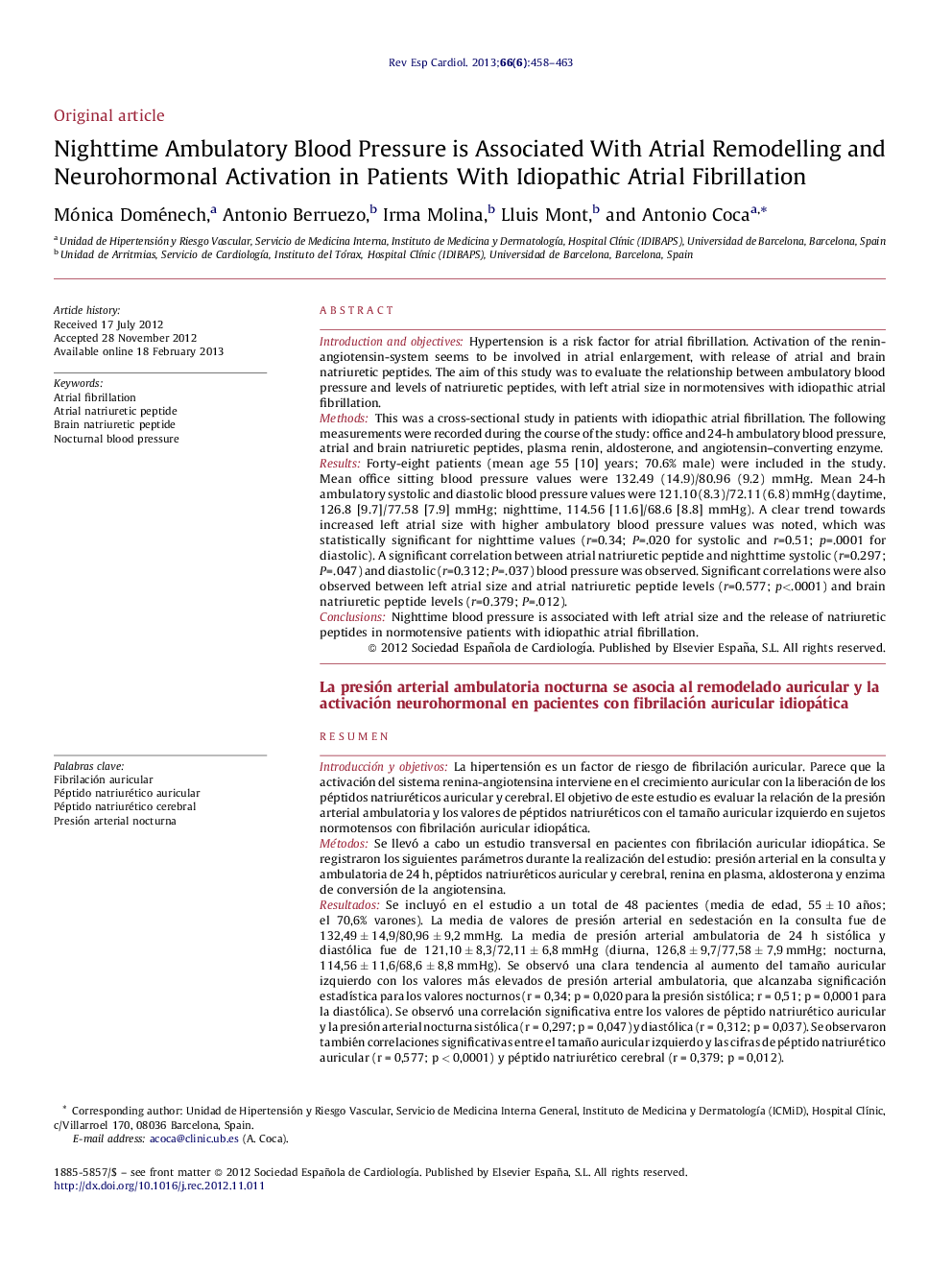| Article ID | Journal | Published Year | Pages | File Type |
|---|---|---|---|---|
| 3017834 | Revista Española de Cardiología (English Edition) | 2013 | 6 Pages |
Introduction and objectivesHypertension is a risk factor for atrial fibrillation. Activation of the renin-angiotensin-system seems to be involved in atrial enlargement, with release of atrial and brain natriuretic peptides. The aim of this study was to evaluate the relationship between ambulatory blood pressure and levels of natriuretic peptides, with left atrial size in normotensives with idiopathic atrial fibrillation.MethodsThis was a cross-sectional study in patients with idiopathic atrial fibrillation. The following measurements were recorded during the course of the study: office and 24-h ambulatory blood pressure, atrial and brain natriuretic peptides, plasma renin, aldosterone, and angiotensin–converting enzyme.ResultsForty-eight patients (mean age 55 [10] years; 70.6% male) were included in the study. Mean office sitting blood pressure values were 132.49 (14.9)/80.96 (9.2) mmHg. Mean 24-h ambulatory systolic and diastolic blood pressure values were 121.10 (8.3)/72.11 (6.8) mmHg (daytime, 126.8 [9.7]/77.58 [7.9] mmHg; nighttime, 114.56 [11.6]/68.6 [8.8] mmHg). A clear trend towards increased left atrial size with higher ambulatory blood pressure values was noted, which was statistically significant for nighttime values (r=0.34; P=.020 for systolic and r=0.51; p=.0001 for diastolic). A significant correlation between atrial natriuretic peptide and nighttime systolic (r=0.297; P=.047) and diastolic (r=0.312; P=.037) blood pressure was observed. Significant correlations were also observed between left atrial size and atrial natriuretic peptide levels (r=0.577; p<.0001) and brain natriuretic peptide levels (r=0.379; P=.012).ConclusionsNighttime blood pressure is associated with left atrial size and the release of natriuretic peptides in normotensive patients with idiopathic atrial fibrillation.
ResumenIntroducción y objetivosLa hipertensión es un factor de riesgo de fibrilación auricular. Parece que la activación del sistema renina-angiotensina interviene en el crecimiento auricular con la liberación de los péptidos natriuréticos auricular y cerebral. El objetivo de este estudio es evaluar la relación de la presión arterial ambulatoria y los valores de péptidos natriuréticos con el tamaño auricular izquierdo en sujetos normotensos con fibrilación auricular idiopática.MétodosSe llevó a cabo un estudio transversal en pacientes con fibrilación auricular idiopática. Se registraron los siguientes parámetros durante la realización del estudio: presión arterial en la consulta y ambulatoria de 24 h, péptidos natriuréticos auricular y cerebral, renina en plasma, aldosterona y enzima de conversión de la angiotensina.ResultadosSe incluyó en el estudio a un total de 48 pacientes (media de edad, 55 ± 10 años; el 70,6% varones). La media de valores de presión arterial en sedestación en la consulta fue de 132,49 ± 14,9/80,96 ± 9,2 mmHg. La media de presión arterial ambulatoria de 24 h sistólica y diastólica fue de 121,10 ± 8,3/72,11 ± 6,8 mmHg (diurna, 126,8 ± 9,7/77,58 ± 7,9 mmHg; nocturna, 114,56 ± 11,6/68,6 ± 8,8 mmHg). Se observó una clara tendencia al aumento del tamaño auricular izquierdo con los valores más elevados de presión arterial ambulatoria, que alcanzaba significación estadística para los valores nocturnos (r = 0,34; p = 0,020 para la presión sistólica; r = 0,51; p = 0,0001 para la diastólica). Se observó una correlación significativa entre los valores de péptido natriurético auricular y la presión arterial nocturna sistólica (r = 0,297; p = 0,047) y diastólica (r = 0,312; p = 0,037). Se observaron también correlaciones significativas entre el tamaño auricular izquierdo y las cifras de péptido natriurético auricular (r = 0,577; p < 0,0001) y péptido natriurético cerebral (r = 0,379; p = 0,012).ConclusionesLa presión arterial nocturna se asocia al tamaño auricular izquierdo y la liberación de péptidos natriuréticos en los pacientes normotensos con fibrilación auricular idiopática.
